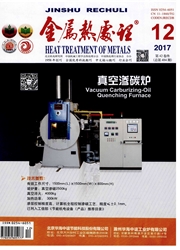

 中文摘要:
中文摘要:
利用水和空气作为淬火介质,对直径为80 mm的Fe-2.4C-12Cr高铬铸球进行多循环淬火-分配-回火(MQ-P-T)处理,并与常规正火和油淬处理后的同尺寸试样的力学性能和微观组织进行对比分析。通过微观表征技术,对MQ-P-T处理后高铬铸铁的强韧化机制进行了探讨。结果表明,经MQ-P-T处理后的高铬铸球径向硬度平均值约为60 HRC,比空冷铸球径向平均硬度约高出17 HRC,比油淬处理试样约提高5 HRC。经MQ-P-T处理后铸球冲击韧度平均值达到12.6 J/cm2,约为空冷冲击韧度的4倍,约为油淬冲击韧度的2倍。经MQ-P-T处理后铸球具有高的硬度和硬度均匀性,其冲击性能亦大大提高。经MQ-P-T处理后铸铁优异的力学性能主要归因于马氏体基体、相当数量的二次碳化物和稳定的残留奥氏体组织。
 英文摘要:
英文摘要:
Based on microstructure desired,Fe-2. 4C-12Cr( mass fraction, %) white cast iron balls are treated by a multicycle quenching-partitioning-tempering( MQ-P-T) process,and such a complex process is first simply performed by alternating water quenching and air cooling. For comparison,the white cast iron balls also were treated by conventional normalization( NOR) process and oil quenching process,respectively. The resultant microstructure was characterized and the effect of the heat treatments on the mechanical properties was evaluated. By means of microscopic characterization technique,the toughening mechanism of white cast iron balls treated by MQ-P-T process was discussed. The results show that,the hardness of 60 HRC are obtained on MQ-P-T white cast iron balls,while the average values in NOR and oil quenching balls are 43 HRC and 55 HRC,respectively. The impact toughness of MQ-P-T ball is 12. 6 J / cm2,which is 4 times larger than NOR ball and 2 times oil quenching one. Microstructural characterization reveals that excellent mechanical properties of the MQ-P-T balls are attributed to the combination of martensite matrix and considerable secondary carbides as well as retained austenite.
 同期刊论文项目
同期刊论文项目
 同项目期刊论文
同项目期刊论文
 High strength-elongation product of Nb-microalloyed low-carbon steel by a novel quenching–partitioni
High strength-elongation product of Nb-microalloyed low-carbon steel by a novel quenching–partitioni Unique impact of ferrite in influencing austenite stability and deformation behavior in a hot-rolled
Unique impact of ferrite in influencing austenite stability and deformation behavior in a hot-rolled The effect of intercritical annealing on the Microstructure and Mechanical Properties in a high Stre
The effect of intercritical annealing on the Microstructure and Mechanical Properties in a high Stre Effect of intercritical annealing time on the microstructures and tensile Properties of a high stren
Effect of intercritical annealing time on the microstructures and tensile Properties of a high stren Effect of Partial Replacement of Si with Al on the Microstructures and Mechanical Properties of 1000
Effect of Partial Replacement of Si with Al on the Microstructures and Mechanical Properties of 1000 Development of Multi-Cycle Quenching–Partitioning–Tempering Process and Its Applications in Engineer
Development of Multi-Cycle Quenching–Partitioning–Tempering Process and Its Applications in Engineer Characterization of microstructures and tensile properties of TRIP-aided steels with different matri
Characterization of microstructures and tensile properties of TRIP-aided steels with different matri Significance of control of austenite stability and three-stage work-hardening behavior of an ultrahi
Significance of control of austenite stability and three-stage work-hardening behavior of an ultrahi Dynamic Compression Behavior and Microstructure of a Novel Low-Carbon Quenching-Partitioning-Temperi
Dynamic Compression Behavior and Microstructure of a Novel Low-Carbon Quenching-Partitioning-Temperi Multi-phase microstructure design of a novel high strength TRIP steel through experimental methodolo
Multi-phase microstructure design of a novel high strength TRIP steel through experimental methodolo Investigation on High Strength Hot-Rolled Plates by Quenching-Partitioning-Tempering Process Suitabl
Investigation on High Strength Hot-Rolled Plates by Quenching-Partitioning-Tempering Process Suitabl Enhanced stability of retained austenite and consequent work hardening rate through pre-quenching pr
Enhanced stability of retained austenite and consequent work hardening rate through pre-quenching pr Work hardening behaviors of a low carbon Nb-microalloyed Si–Mn quenching–partitioning steel with dif
Work hardening behaviors of a low carbon Nb-microalloyed Si–Mn quenching–partitioning steel with dif Deformation temperature dependence of mechanical properties and microstructures for a novel quenchin
Deformation temperature dependence of mechanical properties and microstructures for a novel quenchin Microstructual Evolution of a Nb‐Microalloyed Advanced High Strength Steel Treated by Quenching‐Part
Microstructual Evolution of a Nb‐Microalloyed Advanced High Strength Steel Treated by Quenching‐Part A new effect of retained austenite on ductility enhancement in high-strength quenching-partitioning-
A new effect of retained austenite on ductility enhancement in high-strength quenching-partitioning- 期刊信息
期刊信息
